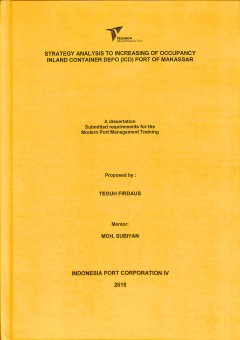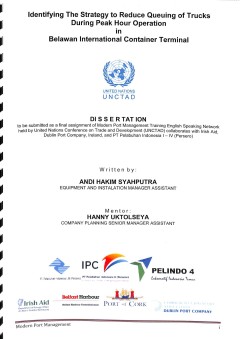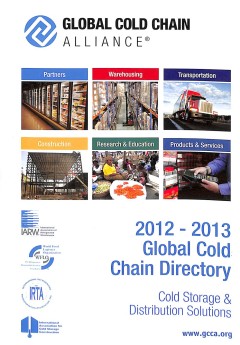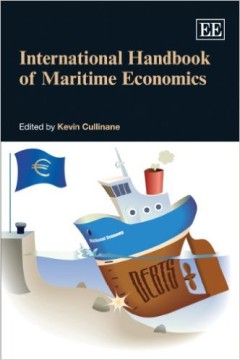Ditapis dengan

Warehousing management : a complete guide to improving efficiency and minimiz…
Warehouses are an integral part of the modern supply chain, involved in sourcing, producing and distributing goods. However, due to the complexities of warehouse operations they can often be one of the most costly parts of the supply chain. Their efficient management is therefore critical for minimizing cost and contributing to an effective and efficient supply chain. Warehouse Management pro…
- Edisi
- -
- ISBN/ISSN
- 978-0-7494-60747
- Deskripsi Fisik
- xvi, 324 p., ; illus : 23 cm
- Judul Seri
- -
- No. Panggil
- LC 658.785 RIC w

Strategy analysis to increasing of occupancy inland container depo (ICD) port…
Inland Container Depo (ICD) is one of the facilities owned by PT (Persero) Pelabuhan Indonesia IV of Makassar. The Average growth of containers through the Makassar. The average growth of containers through the Makassar Container Terminal 9%, but it is contrary to the ICD occupancy decreased from year to year due to there are some container depot outside the port as a competitor. So that the …
- Edisi
- -
- ISBN/ISSN
- -
- Deskripsi Fisik
- v, 70 p, 30 cm; tabel
- Judul Seri
- -
- No. Panggil
- TD PO FIR s

Identifying the strategy to reduce queuing of trucks during peak hour operati…
Belawan International Container Terminal especially serves export and import container by activities loading, discharge, receiving, delivery and behandle. These terminal in the main entrance gate container to North Sumatera, Aceh and most Riau. Recently, the terminal face the queue of trucks at peak time operation. These condition reduce terminal's level of service. This paper will evaluate a…
- Edisi
- -
- ISBN/ISSN
- -
- Deskripsi Fisik
- ix, 20 p., ; 33 cm
- Judul Seri
- -
- No. Panggil
- TD LO SYA i

Modern Port Management Training
This document is intended to study the saving cost of RTG, using electrification comparing usage of diesel engine. This study is intended to give an idea of how much costs can be in saving from the use of electrical shore power connection. The big challenge for the management of PT. Pelabuhan Indonesia IV (Persero) especially Makassar Container Terminal to be abl…
- Edisi
- -
- ISBN/ISSN
- -
- Deskripsi Fisik
- 24 p, 30 cm
- Judul Seri
- -
- No. Panggil
- PO DJU m

Global cold chain directory 2012 - 2013 : cold storage & distribution solution
Global cold chain directory 2012 - 2013 : cold storage & distribution solution
- Edisi
- -
- ISBN/ISSN
- -
- Deskripsi Fisik
- 464 p., 26 cm
- Judul Seri
- -
- No. Panggil
- LC 388.0425 GLO g

International Handbook of Maritime Economics
This timely and comprehensive new Handbook brings together an unrivaled group of distinguished scholars and practitioners to provide in-depth analysis and a contemporary perspective on a wide-ranging array of topics in maritime economics. Inherently global in nature, the economics of the maritime sector has proved pivotal in facilitating globalization and international trade. This HandbOOK o…
- Edisi
- -
- ISBN/ISSN
- 978-1-84720-933-7
- Deskripsi Fisik
- xix, 497 hlm., 21 cm
- Judul Seri
- -
- No. Panggil
- TXT MR CUL i

THE IMPORTANCE OF TECHNOLOGICAL INNOVATION IN THE LOGISTICS OF ETHANOL EXPORTS
This paper analyzes the technological status of the bulk liquids logistical process at the port of Santos. The main objective is to identify problems encountered in port logistics for the export of ethanol and evaluate their respective technological innovation perspectives. Ethanol exports have increased given international environmental appeals. Within the complex and uncertain environments th…
- Edisi
- v. 3, n. 1, pp. 58 - 84, Jan./Jul. 2011
- ISBN/ISSN
- ISSN 2175-5825
- Deskripsi Fisik
- 27 p.
- Judul Seri
- -
- No. Panggil
- ATC LO PET t

THE ROLE OF TRANSPORTATION IN LOGISTICS CHAIN
The operation of transportation determines the efficiency of moving products. The progress in techniques and management principles improves the moving load, delivery speed, service quality, operation costs, the usage of facilities and energy saving. Transportation takes a crucial part in the manipulation of logistic. Reviewing the current condition, a strong system needs a clear frame of logist…
- Edisi
- Vol. 5, pp. 1657 - 1672, 2005
- ISBN/ISSN
- 1657 - 1672
- Deskripsi Fisik
- 16 p.
- Judul Seri
- Proceedings of the Eastern Asia Society for Transportation Studies
- No. Panggil
- ATC LO TSE t

Unified heuristics to solve routing problem of reverse logistics in sustainab…
A reverse logistics problem, motivated by many real-life applications, is examined where bottles/cans in which products are delivered from a processing depot to customers in one period are available for return to the depot in the following period. The picked-up bottles/cans need to be adjusted in the place of delivery load. This problem is termed as simultaneous delivery and pick-up problem wit…
- Edisi
- Vol. 41, No. 3, March 2010, 337–351
- ISBN/ISSN
- 1464–5319
- Deskripsi Fisik
- 16 p.
- Judul Seri
- International Journal of Systems Science
- No. Panggil
- ATC LO ANB u

The Third-Party Logistics Services and Globalization of Manufacturing
Cross-border production chains of manufacturing require coordination and logistics. Third-party logistics services have thus taken this role as a link in the globalization of economic activities. Distriparks, a provider of total logistics to manufacturing, have emerged in Singapore to offer customized distribution and inventory management. Established as a traditional entrepoˆt by internationa…
- Edisi
- Vol. 7, No. 1, 89–104, 2002
- ISBN/ISSN
- 1469-9265
- Deskripsi Fisik
- 18 p.
- Judul Seri
- International Planning Studies
- No. Panggil
- ATC LO ZHU t

The terminalization of supply chains: reassessing the role of terminals in po…
The paper discusses how logistics service providers are using terminals in their supply chains. It argues that an increasing ‘terminalization’ of supply chains is unfolding, whereby seaport and inland terminals are taking up a more active role in supply chains by increasingly confronting market players with operational considerations such as imposing berthing windows, dwell time charges, tr…
- Edisi
- VOL. 36, NO. 2, 165–183
- ISBN/ISSN
- 1464–5254
- Deskripsi Fisik
- 21 p.
- Judul Seri
- Maritime Policy & Management: The flagship journal of international shipping and port research
- No. Panggil
- ATC LO ROD t

The modelling of factors determining the goods and traffic flows movement in …
The purpose of this atticle is to model the factors determining the goods traffic along the logistical channels located in various geopolitical regions on the basis of the transport network. The attention is focused on theoretical presumption of logistical channels formation in a logistical system. In this modeling the factors which determine the formation of the goods flow along the subsystems…
- Edisi
- 2003, Vol XVIII. No 1, 18-22
- ISBN/ISSN
- 1648-3480
- Deskripsi Fisik
- 6 p.
- Judul Seri
- Transport
- No. Panggil
- ATC LO JAR t

The Limits of Public Policy Intervention in Urban Logistics: Lessons from Vic…
For over 15 years, the subject of urban logistics has preoccupied many stakeholders, including both private and public decision-makers. The purpose of this paper is to present a study of the limits of public policy regulations restricting vehicle access to limited traffic zones to promote the use of urban consolidation centres (UCCs). After examining the main technical and economic aspects of i…
- Edisi
- Vol. 21, No. 10, 1528–1541
- ISBN/ISSN
- -
- Deskripsi Fisik
- 15 p.
- Judul Seri
- European Planning Studies
- No. Panggil
- ATC LO VIL t

The Coming of Age of Business Logistics
This study reviews the admission criteria for a "nontraditional" MBA program by investigating a group of students who in academia. This article reviews past and current trends in the discipline of logistics and reports on the growing placement opportunities for students with degrees in business logistics as more firms create formal logistics organizations and solicit college graduates with cour…
- Edisi
- -
- ISBN/ISSN
- -
- Deskripsi Fisik
- 5 p.
- Judul Seri
- Journal of Education for Business
- No. Panggil
- ATC LO RUS t

System reliability for a multistate intermodal logistics network with time wi…
Network structures have been diffusely adopted in logistics systems, where the most critical target is completing the delivery within the promised timeframe. This paper focuses on a single commodity in a multistate intermodal logistics network (MILN) with transit stations and routes to involve three parameters: a route’s capacity, delivery time and time window. There is a carrier along each r…
- Edisi
- 2016
- ISBN/ISSN
- 1366-588X
- Deskripsi Fisik
- 14 p.
- Judul Seri
- International Journal of Production Research
- No. Panggil
- ATC LO LIN s

Sustainability assessment of food chain logistics
Food chain logistics plays an important role in the sustainability performance of the food sector. Therefore, project SCALE (Step Change in Agri-food Logistics Ecosystems) started as a collaborative international project, aiming for tools and frameworks for the food sector to make a step change in operational practices. A sustainability framework is introduced to propose a structured and ration…
- Edisi
- Vol. 18, No. 2, 101–117
- ISBN/ISSN
- 1469-848X
- Deskripsi Fisik
- 18 p.
- Judul Seri
- International Journal of Logistics Research and Applications
- No. Panggil
- ATC LO BLO s

Research on public logistics centre as tool for cooperation
This paper focuses on logistics centre concept and benefits for users. Intermodal benefit, forwarders impact, IT solutions, new transport flows due to synergy, better supply chain management, additional services, cost sharing, economies of scale, quality of the services, know-how, joint marketing impact, and benefit for growth of third-party logistics services are presented. The main bottleneck…
- Edisi
- 2007, Vol XXII, No 1, 50–54
- ISBN/ISSN
- 1648-3480
- Deskripsi Fisik
- 6 p.
- Judul Seri
- Transport
- No. Panggil
- ATC LO JAR r

Relevance of City Logistics Modelling Efforts: A Review
This paper presents a review of city logistics (also known as urban freight transportation) modelling efforts reported in the literature for urban freight analysis. The review is based on an extensive search of the academic literature. We position the contributions in a framework that takes into account the diversity and complexity found in the present-day city logistics practice. The framework…
- Edisi
- 2015
- ISBN/ISSN
- 1464-5327
- Deskripsi Fisik
- 20 p.
- Judul Seri
- Transport Reviews A Transnational Transdisciplinary Journal
- No. Panggil
- ATC LO ANA r

Redesigning international manufacturing and logistics structures
Introduction Border-crossing activities of many firms have increased substantially during the past three decades, either by international trade or by establishing manufacturing and/or distribution facilities abroad. Many observers consider these “globalization” processes to be one of the major business challenges for the 1990s and beyond[1,2]. The design and control of emerging internation…
- Edisi
- Vol. 27 No. 7, 1997, pp. 377-394.
- ISBN/ISSN
- 0960-0035
- Deskripsi Fisik
- 20 p.
- Judul Seri
- International Journal of Physical Distribution & Logistics Management
- No. Panggil
- ATC LO VOS r

Realizing Logistics Opportunities in a Public–Private Collaborative Setting…
This paper gives insight into a process of regional logistics collaboration as it progressed in the peripheral region of Skaraborg, western Sweden, between 2000 and 2007. The region underwent a transformation in the way public and private actors collaborate in logistics. The focus of the collaboration was to develop the logistics competitiveness in the region, mainly through the establishment o…
- Edisi
- Vol. 28, No. 2, 219–237, March 2008
- ISBN/ISSN
- 1464-5327
- Deskripsi Fisik
- 20 p.
- Judul Seri
- Transport Reviews: A Transnational Transdisciplinary Journal
- No. Panggil
- ATC LO BER r

Perception of Malaysian Food Manufacturers Toward Halal Logistics
This article measures the perception of Malaysian food manufacturers toward halal logistics through an industry survey conducted in Malaysia. Based on a survey with 44 food manufacturers in Malaysia, results indicate that the responsibility of halal logistics according to the manufacturer is a shared responsibility in the halal food supply chain and value chain. Second, the study confirms that …
- Edisi
- 26:218–233, 2014
- ISBN/ISSN
- 1528-6983
- Deskripsi Fisik
- 17 p.
- Judul Seri
- Journal of International Food & Agribusiness Marketing
- No. Panggil
- ATC LO TIE p.

Optimal location and size of logistics parks in a regional logistics network …
This paper proposes a model to address the design problem of a regional logistics network. In the proposed model, the decision variables include the location and size of logistics parks. The interaction between the logistics authority and logistics users as well as the effects of economies of scale and CO2 emission taxes on the logistics network design are explicitly considered. The proposed mo…
- Edisi
- 2015
- ISBN/ISSN
- 1648-3480
- Deskripsi Fisik
- 18 p.
- Judul Seri
- Transport
- No. Panggil
- ATC LO ZHA o

Optimal collaborative transportation service trading in B2B e-commerce logistics
This paper investigates a less-than-truckload carrier collaboration decision-making problem in the e-commerce logistics network. E-commerce less-than-truckload carrier collaboration problem considers multiple logistics service providers (LSPs) forming a collaborative alliance in an e-commerce logistics network. They share their transportation requests and vehicle capabilities to maximise the to…
- Edisi
- 2017
- ISBN/ISSN
- 1366-588X
- Deskripsi Fisik
- 18 p.
- Judul Seri
- International Journal of Production Research
- No. Panggil
- ATC LO ZHA o

Understanding supply chain management concepts in the context of port logisti…
In academia as in practice, seaports are increasingly viewed as elements in supply chains. It is argued that seaports should add value to shippers by aligning their own business activities with shippers’ Supply Chain Management (SCM) strategies and requirements. The implications of this ‘port-SCM’ philosophy are not fully explored, however. In this context, it is especially important to c…
- Edisi
- 2014 Volume 29(4): 376–385
- ISBN/ISSN
- 1648-3480
- Deskripsi Fisik
- 11 p.
- Judul Seri
- Transport
- No. Panggil
- ATC LO HER u

Maritime logistics in Asia
On 11 July 1404, Zheng He (AD 1371–1435) departed from the east coast of China on his first voyage to the West. Nearly 90 years later, on 3 August 1492, Christopher Columbus departed on his first voyage to the other side of the world. Global navigation opened a new chapter in human history. Since then, maritime logistics has indeed turned the earth into the global village that we see today, a…
- Edisi
- VOL. 35, NO. 1, 1–3
- ISBN/ISSN
- 1464–5254
- Deskripsi Fisik
- 3 p.
- Judul Seri
- Maritime logistics in Asia
- No. Panggil
- ATC LO EDI m

Linking ocean container carrier capabilities to shipper–carrier relationshi…
As outsourcing and offshoring continue to expand, the ocean container industry serves a critical and still increasing role in supporting global trade. Yet, perceived commoditization and intense price competition among ocean container carriers limit opportunities for competitive advantage and formation of long-term shipper–carrier relationships. This environment ultimately yields an unhealthy …
- Edisi
- 2016
- ISBN/ISSN
- 1464-5254
- Deskripsi Fisik
- 18 p.
- Judul Seri
- Maritime Policy & Management The flagship journal of international shipping and port research
- No. Panggil
- ATC LO MAL l

Joint planning for yard storage space and home berths in container terminals
Yard planning is essential for efficient operations in container terminals, especially for ports with limited storage space. To improve the utilisation of space and the efficiency of container handling in a terminal, operators require flexible yard space planning strategies to manage job workloads and yard-to-berth transportation costs. In previous studies, the inter-related decision making pro…
- Edisi
- Vol. 51, No. 10, 3143–3155
- ISBN/ISSN
- -
- Deskripsi Fisik
- 14 p.
- Judul Seri
- International Journal of Production Research
- No. Panggil
- ATC LO KUN j

Integrating logistics into the outsourcing process
In this paper, a general outsourcing process was derived from the literature; important areas of logistics to be considered during an outsourcing process were then categorised and related to this process. The process was applied to empirical data from three companies. All three companies included all phases of the general outsourcing process in their outsourcing projects. The derived process th…
- Edisi
- Vol. 12, No. 4, August 2009, 281–298
- ISBN/ISSN
- 1469-848X
- Deskripsi Fisik
- 19 p.
- Judul Seri
- International Journal of Logistics Research and Applications
- No. Panggil
- ATC LO FRE i

Integrating intermodal transport with logistics: a case study of the UK retai…
Retail traffic is one of the main drivers for the growth of intermodal transport services in the UK. This paper examines the key factors underpinning this modal shift in order to learn lessons for other market and geographical contexts. Since successful retail intermodal logistics involves many actors, this paper is based on semi-structured interviews with major UK retailers, third-party logist…
- Edisi
- Vol. 38, No. 3, 347–374
- ISBN/ISSN
- -
- Deskripsi Fisik
- 29 p.
- Judul Seri
- Integrating intermodal transport with logistics
- No. Panggil
- ATC LO MON i

Infrastructure and logistics divide: regional comparisons between North Easte…
Only recently has the inequity among territories in terms of infrastructures and logistics services for freight transport become the subject of several studies regarding measurement and assessment of operational functionality and correspondence of supply for real mobility needs. The efficiency and competitiveness of territories are features that may be analysed through various parametric-type a…
- Edisi
- -
- ISBN/ISSN
- 2029-4921
- Deskripsi Fisik
- 28 p.
- Judul Seri
- Technological and Economic Development of Economy
- No. Panggil
- ATC LO CAR i

ICT adoption in multimodal transport sites: Investigating institutional-relat…
Seaports represent a major component of multimodal transport networks and they are key in the operation of supply chains and global logistics. In multimodal transport networks it is well acknowledged the use of information and communication technology (ICT) can deliver benefits that include real time track and trace, visibility and reduced lead-time, among others. Given the importance of the be…
- Edisi
- 2017
- ISBN/ISSN
- -
- Deskripsi Fisik
- 20 p.
- Judul Seri
- ICT adoption in multimodal transport sites
- No. Panggil
- ATC LO MON i

Impact of scale increase of container ships on the generalised chain cost
In recent years, an increase in the size of the container ships could be observed. The question is how these larger ships will influence the total generalised costs from a port of loading to a destination in the European hinterland. The second question is whether a scale increase of the container ships on other loops, such as a loop from the United States to Europe, has the same impact on the g…
- Edisi
- Vol. 43, No. 2, 192–208
- ISBN/ISSN
- 1464-5254
- Deskripsi Fisik
- 18 p.
- Judul Seri
- Maritime Policy & Management The flagship journal of international shipping and port research
- No. Panggil
- ATC LO HAS i

Greening ports and maritime logistics: A review
This paper aims to examine the past and present research on ‘green ports and maritime logistics’ in order to identify established research streams and fertile research areas with potential for future investigations. Using rigorous bibliometric and network analysis tools, the paper completes a systemic mapping of the existing literature and identifies the key investigators, collaboration pat…
- Edisi
- 2015
- ISBN/ISSN
- -
- Deskripsi Fisik
- 15 p.
- Judul Seri
- Greening ports and maritime logistics
- No. Panggil
- ATC LO DAV g

GREEN LOGISTICS STRATEGY FOR SOUTH EAST EUROPE: TO IMPROVE INTERMODALITY AND …
This article describes the trend towards European green initiatives in the transport sector. The introduction of green logistics management and green policy in Europe has been analysed to understand better the positive impact of green policy on environment, society and economy. With the most recent EU initiatives in the field of green logistics, intermodality has become the platform for green l…
- Edisi
- 2012 Volume 27(1): 25-33
- ISBN/ISSN
- 1648-3480
- Deskripsi Fisik
- 10 p.
- Judul Seri
- GREEN LOGISTICS STRATEGY FOR SOUTH EAST EUROPE
- No. Panggil
- ATC LO BES g

Framing the Nexus of Globalisation, Logistics and Manufacturing in Europe
Under the ongoing influence of globalisation, supply chains have changed significantly. New logistics and manufacturing systems have emerged, causing longer transport distances and increasing transport emissions. The existing research into the sustainability impacts of freight transport has largely viewed it as being a macro-level economic and political phenomenon and has ignored the interdepen…
- Edisi
- Vol. 34, No. 6, 674–690
- ISBN/ISSN
- -
- Deskripsi Fisik
- 19 p.
- Judul Seri
- Transport Reviews: A Transnational Transdisciplinary Journal
- No. Panggil
- ATC LO AKY f

Firm-specific Effects on Location Decisions of Foreign Direct Investment in C…
HONG J. (2007) Firm-specific effects on location decisions of foreign direct investment in China’s logistics industry, Regional Studies 41, 673–683. This paper uses conditional logit models to investigate firms-specific effects on location decisions of foreign direct investment in China’s logistics industry. Based on a recent census database, the empirical results indicate that the import…
- Edisi
- Vol. 41.5, pp. 673–683, July 2007
- ISBN/ISSN
- 1360-0591
- Deskripsi Fisik
- 12 p.
- Judul Seri
- Regional Studies
- No. Panggil
- ATC LO HON f

Estimating trade-off among logistics cost, CO2 and time: A case study of cont…
One of the basic necessary conditions for successful implementation of policies which encourage the use of intermodal freight transportation systems is to understand ‘‘what the desired mode share of the intermodal freight transportation systems is’’ and also ‘‘what the trade-off relationships among various concerns such as logistics cost, time and CO2 emissions are’’. The object…
- Edisi
- Vol. 16, No. 1, March 2012, 85–98
- ISBN/ISSN
- 2161-6779
- Deskripsi Fisik
- 16 p.
- Judul Seri
- International Journal of Urban Sciences
- No. Panggil
- ATC LO PAR e

Establishing an order allocation decision support system via learning curve m…
Apparel firms confront the problem with effective order allocation among factories when conducting global logistics operations. The problem is non-deterministic polynomial-time hard and often complicated to obtain an optimal solution. This research tried to solve, by heuristic method, the problem via applying the learning curve to the capacity planning to improve the decision-making on global l…
- Edisi
- Vol. 31, No. 5, 274–285
- ISBN/ISSN
- -
- Deskripsi Fisik
- 13 p.
- Judul Seri
- Journal of Industrial and Production Engineering
- No. Panggil
- ATC LO CHE e

Enhanced logistics service provider framework for higher integration and effi…
The concept of maritime logistics results from the convergence of maritime transport and supply chains. The paper aims to propose an enhanced logistics service provider (LSP) framework which facilitates LSPs to integrate supply chains in an optimal manner by utilising their unique expertise and experience. In the framework, the enhanced LSP serves as the single contact point for shippers and as…
- Edisi
- Vol. 17, No. 2, 89–113
- ISBN/ISSN
- -
- Deskripsi Fisik
- 27 p.
- Judul Seri
- International Journal of Logistics Research and Applications: A Leading Journal of Supply Chain Management
- No. Panggil
- ATC LO LAM e

Economical evaluation of logistics centres establishment
This paper presents a method for assessing the financial viability of a new Freight village financed by private and public investments. The financial evaluation model constitutes four distinct phases, namely (a) site selection and traffic forecasts, (b) definition of services offered and corresponding dimensions, (c) estimation of investment and operation costs and (d) evaluation of investments…
- Edisi
- Vol XXII, No 2, 111–117
- ISBN/ISSN
- 1648-3480
- Deskripsi Fisik
- 8 p.
- Judul Seri
- Transport
- No. Panggil
- ATC LO MEI e

Dissolving Bologna: tensions between citizenship and the logistics city
The contemporary crisis of the nation-State’s paradigms lead to the resurgence of the city as a political space of action. However, the very concept of the city itself is being profoundly reshaped by new global processes. During the last years a cycle of struggles in Northern Italy’s logistics sector, with an epicentre in Bologna, has revealed many aspects of this crisis of the traditional …
- Edisi
- 2017
- ISBN/ISSN
- 1469-3593
- Deskripsi Fisik
- 14 P.
- Judul Seri
- Citizenship Studies
- No. Panggil
- ATC LO CUP d

Determination and evaluation of the factors of outsourcing logistics
This paper focusess on the determination and evaluation of the factors of logistic outsourching. Many authors usually talk about logistic service outsourcing and it reason and benefit as well, but if some functions of the service are not outsourced, we can not really entitle “outsourcing” as the whole service providing. If logistic actifity if one or several functions are outsourced it is n…
- Edisi
- 2006, Vol XXI, No 1, 44–47
- ISBN/ISSN
- 1648-3480
- Deskripsi Fisik
- 5 p.
- Judul Seri
- Transport
- No. Panggil
- ATC LO JAR d

Determine the optimal carrier selection for a logistics network based on mult…
From the perspective of supply chain management, the selected carrier plays an important role in freight delivery. This article proposes a new criterion of multi-commodity reliability and optimises the carrier selection based on such a criterion for logistics networks with routes and nodes, over which multiple commodities are delivered. Carrier selection concerns the selection of exactly one ca…
- Edisi
- Vol. 44, No. 5, May 2013, 949–965
- ISBN/ISSN
- 1464–5319
- Deskripsi Fisik
- 18 p.
- Judul Seri
- International Journal of Systems Science
- No. Panggil
- ATC LO LIN y

Determinants and Effects of Logistics Costs in Container Ports: The Transacti…
Many countries seek to become a global logistics center linking major trading ports. They are competitively constructing container ports. The aggressive competition creates overcapacity situation in the container port sector. Massive investments are required to construct container ports with terminals, docks, storage areas and hinterlands. Nevertheless, it is not easy for container ports to hav…
- Edisi
- Volume 30 Number 2 August 2014 pp. 193-216
- ISBN/ISSN
- -
- Deskripsi Fisik
- 23 p.
- Judul Seri
- Determinants and Effects of Logistics Costs in Container Ports
- No. Panggil
- ATC LO CHO d

Information Technology as the Main Competence in the Design of the Strategic …
The creation of logistical support structures aims to help improve the performance of logistics along supply chains, a context where the Logistics Platforms have been gaining increasing prominence. A frequent difficulty in these ventures is to align strategic planning with the flow of cargo and the ability of the adjacent port areas. Aiming to contribute to the understanding of the importance o…
- Edisi
- 2013, Volume 8, Issue 3
- ISBN/ISSN
- 0718-2724
- Deskripsi Fisik
- 13 p.
- Judul Seri
- Journal of Technology Management and Innovation
- No. Panggil
- ATC LO VAR i

Defining maritime logistics hub and its implication for container port
Since the hub-and-spoke concept was introduced to the aviation market after the US airline deregulation in the late 1970s, it becomes a primary distribution model employed by leading international logistics companies. This pattern drives the companies to consolidate shipments on the large scale at major terminals (i.e. hub) and to redistribute the smaller scale of shipments to their respective …
- Edisi
- VOL. 38, NO. 3, 269–292
- ISBN/ISSN
- 1464–5254
- Deskripsi Fisik
- 25 p.
- Judul Seri
- Maritime Policy & Management: The flagship journal of international shipping and port research
- No. Panggil
- ATC LO NAM d

CONNECTING SMALL AND MEDIUM ENTERPRISES TO THE GLOBAL MARKET VIA THE GLOBAL L…
Developing countries, such as Taiwan, Singapore and Korea, are transforming to a multi-faceted consumer economy where financial services, medical services, research and development, education, distribution services, international business, technology product development and design, and retail development are fueling economic growth. The logistic and distribution services as a result have become…
- Edisi
- Vol. 19, No. 5, pp. 75-87 (2002)
- ISBN/ISSN
- -
- Deskripsi Fisik
- 15 p.
- Judul Seri
- Journal of the Chinese Institute of Industrial Engineers
- No. Panggil
- ATC LO HOU c

Competitive Positioning in International Logistics: Identifying a System of A…
Firms involved in international logistics must develop a system of service attributes that give them a way to be profitable and to satisfy customers’ needs at the same time. How customers trade-off these various attributes in forming satisfaction with competing international logistics providers has not been explored well in the literature. This study explores the ocean freight shipping sector…
- Edisi
- Vol. 20(1) 2006
- ISBN/ISSN
- -
- Deskripsi Fisik
- 16 p.
- Judul Seri
- Journal of Global Marketing
- No. Panggil
- ATC LO DUR c

Competency Profile of Managers in the Singapore Logistics Industry
In this paper, we aim to explore what competencies are essential for logistics managers to be successful in the future by developing a conceptual framework of competency profile of logistics managers based on the existing BLM model and some newly proposed competencies, taking into account changes in the business environment. A survey was conducted in Singapore with logistics managers from 350 f…
- Edisi
- Volume 28 Number 2 August 2012 pp. 161-182Jour
- ISBN/ISSN
- -
- Deskripsi Fisik
- 22 p.
- Judul Seri
- in the Singapore Logistics Industry The Asian Journal of Shipping and Logistics ● Volume 28 Number 2 August 2012 pp. 161-182
- No. Panggil
- ATC LO THA c

Comparison of vehicle types at an automated container terminal
At automated container terminals, containers are transshipped from one mode of transportation to another. Automated vehicles transport containers fromthe stack to the ship and vice versa. Two different types of automated vehicles are studied in this paper, namely automated lifting vehicles and automated guided vehicles. An automated lifting vehicle is capable of lifting a container from the gro…
- Edisi
- 2004
- ISBN/ISSN
- -
- Deskripsi Fisik
- 27 p.
- Judul Seri
- Comparison of vehicle types at an automated container terminal
- No. Panggil
- ATC LO VIS c
 Karya Umum
Karya Umum  Filsafat
Filsafat  Agama
Agama  Ilmu-ilmu Sosial
Ilmu-ilmu Sosial  Bahasa
Bahasa  Ilmu-ilmu Murni
Ilmu-ilmu Murni  Ilmu-ilmu Terapan
Ilmu-ilmu Terapan  Kesenian, Hiburan, dan Olahraga
Kesenian, Hiburan, dan Olahraga  Kesusastraan
Kesusastraan  Geografi dan Sejarah
Geografi dan Sejarah